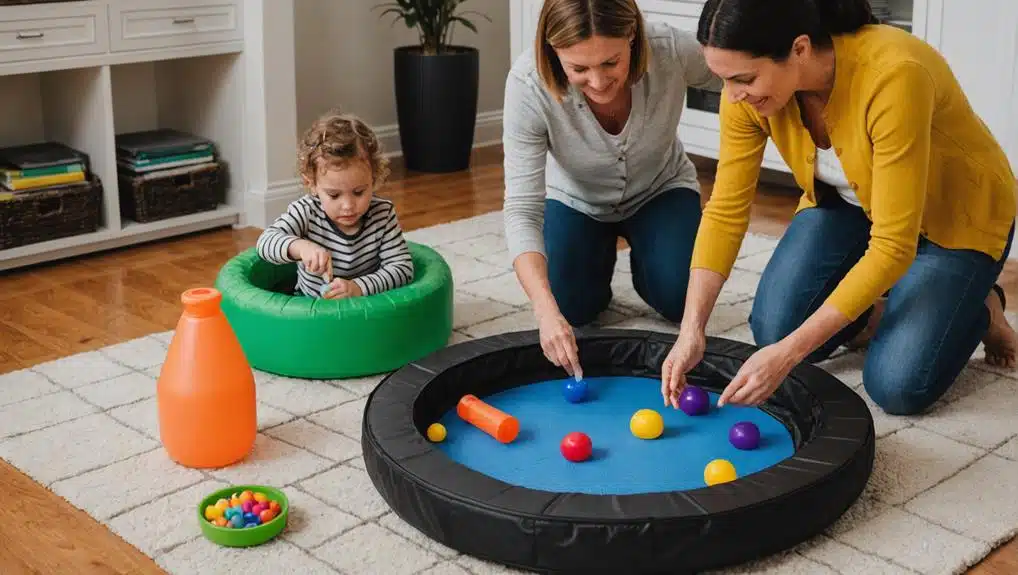Creating a sensory diet is a personalized plan of activities designed to give children the sensory input they need to stay focused and organized throughout the day. This process can seem challenging for parents, but it also presents an opportunity to support their child’s development. This guide offers practical tips to help you understand and create a sensory diet tailored to your child’s unique needs, which can improve focus, emotional regulation, and overall well-being.
Parents can help their children process sensory information more effectively by creating a sensory diet. These plans can make a big difference in a child’s cognitive function, social interactions, and ability to manage daily tasks. Parents may see life-changing improvements in their child’s ability to navigate the world confidently with the proper sensory diet.
Key Takeaways
- Sensory diets require detailed assessment and planning and are personalized. They incorporate activities like balance board challenges and vestibular swinging exercises.
- Implementing a sensory diet involves using specialized tools, creating calm spaces, and monitoring its effectiveness through behavior logs and mood charts.
- Sensory diets should be integrated into daily routines, and consistency is crucial for self-regulation and daily functioning.
- Recognize signs of sensory overload, such as sudden withdrawal, agitation, and discomfort during sensory activities, and adapt the sensory diet accordingly.
- Different age groups have specific sensory needs; babies and toddlers require movement and tactile experiences, while teens need help with emotional regulation and stress management.
Understanding Sensory Diets
Diving into the world of sensory diets, it’s vital to grasp the concept of this personalized approach. A sensory diet, coined in 1984 by Patricia Wilbarger, is a tailored schedule of sensory activities designed to meet specific needs. These activities could range from proprioceptive exercises, like bouncing on a trampoline, to auditory exercises, such as listening games. The primary goal is to improve sensory behaviors, thereby improving the individual’s overall functioning in daily life.
Creating a sensory diet involves a detailed assessment, trial, and scheduling strategies. This process requires a deep understanding of the individual’s sensory needs and preferences, often involving specialized tools such as sensory swings or light-up toys. The objective is to create a personalized regimen that accurately addresses each person’s needs.
Each sensory diet is meticulously crafted using therapeutic activities tailored to the individual’s needs. It is vital to consistently monitor the effectiveness of this sensory regimen and adjust as necessary to ensure the best results.
In essence, a sensory diet is more than just a list of activities; it is a comprehensive strategy designed with empathy and understanding, aiming to improve the individual’s sensory experience and enhance their quality of life. The following section will explore the intricacies of crafting a sensory diet template.
Crafting a Sensory Diet Template
Creating a sensory diet blueprint demands a comprehensive grasp and meticulous approach. This personalized timetable of sensory activities is crafted to cater to the person’s specific requirements. It goes beyond simply applying sensory stimuli; it necessitates tailored clinical planning for successful execution.
The sensory diet blueprint is significant in fostering self-regulation and addressing sensory behaviors. It also plays a notable role in improving daily functioning. When developing sensory diet blueprints, it is vital to explore activities like balance board challenges and vestibular swinging exercises, which are recognized for enhancing motor skills and sensory processing.
Several steps must be taken:
- Initially, an evaluation is essential to grasp the person’s sensory needs and preferences.
- Subsequently, different strategies are tested to identify the most effective ones for the person.
- Ultimately, the most efficient strategies are integrated into a schedule that is easy to follow.
Designing a sensory diet blueprint is a cooperative endeavor that involves clinical insights and scheduling tactics. With appropriate knowledge and methods, a sensory diet can be devised that caters to the person’s requirements, enabling them to better interact with their surroundings.
Implementing Sensory Diet Strategies

Successful implementation of a sensory diet necessitates a systematic plan and vigilant execution. It begins with thoroughly analyzing the child’s sensory needs and identifying their unique preferences. The strategies for implementing a sensory diet must be tailored to the child’s sensory profile. This personalized approach significantly improves the child’s ability to function and engage effectively in their surroundings.
Incorporating sensory-friendly activities regularly and creating calm spaces equipped with sensory tools can significantly minimize sensory overload. A structured template, such as the Daily Sensory Diet Sheet, provides an organized and consistent method for incorporating sensory activities into the child’s routine. This tool assists parents in delivering focused and balanced sensory experiences, which is essential for successful sensory regulation.
The execution of the sensory diet, however, does not stop at mere application. Monitoring the diet’s effectiveness is vital to its success. The Sensory Diet Effectiveness Tool is an excellent resource, enabling parents to track progress and make necessary adjustments promptly.
Monitoring and Adapting the Diet
Monitoring and adjusting a sensory diet is a dynamic process requiring continuous evaluation and adjustment. As a parent, it’s vital to guarantee the diet’s effectiveness and successful transfer across different settings, like home and school. Implementing deep-pressure techniques into your child’s daily routine can enrich their sensory experiences and add structure and comfort to their sensory world.
Subjective assessments, including behavior logs and mood charts, are critical to this process. These tools can provide valuable insights into the progress of the sensory diet and its impact on your child’s behavior and self-regulation. Consistent tracking is essential to understanding how effective the sensory diet is for your child.
Consider using tools such as:
- The Daily Sensory Diet Sheet: This can help track activities and outcomes, clearly showing what strategies work.
- The Sensory Diet Effectiveness Tool: This quantitative tool can provide data on the impact of the diet on your child’s behavior and self-regulation.
- Regular parental observations and feedback: Your insights are crucial for adjusting the sensory diet based on your child’s progress.
Remember that the continuous monitoring and adjusting of the sensory diet are vital steps to guarantee the ongoing support and success of your child’s personalized sensory diet.
Sensory Diets in Daily Life

Having discussed the importance of evaluating and refining the sensory diet, it’s just as significant to understand how to incorporate this personalized schedule into everyday life. A sensory diet isn’t separate but should be intertwined with the child’s daily activities.
Creating a sensory diet that fits seamlessly into daily routines requires understanding the child’s needs and distinct sensory profile. For example, a hyperactive child may benefit from movement-based sensory diet activities in the morning to help them self-regulate and focus at school. On the other hand, a sensory avoider may need calming sensory input during changes to prevent overwhelm.
Consistency is also critical in implementing a sensory diet. Regularly scheduled sensory inputs provide predictability for the child, aiding overall self-regulation. Here’s a sample daily sensory diet schedule:
| Time | Activity | Sensory System Targeted |
|---|---|---|
| Morning | Trampoline Jumping | Proprioceptive |
| Lunch | Chewy Foods | Oral |
| After School | Weighted Blanket | Tactile |
| Bedtime | Soft Music | Auditory |
Recognizing Sensory Overload
Understanding sensory overload is fundamental to the successful implementation of a sensory diet. Sensory overload refers to a state where the brain receives an excessive amount of sensory information, causing anxiety, meltdowns, and difficulty focusing. This overload can be a symptom of Sensory Processing Disorder, a condition affecting all senses, and it bears similarities to ADHD regarding challenges with sensory integration. Recognizing sensory overload is a critical skill for parents, as it enables them to adjust sensory input, thereby preventing unnecessary distress and promoting their child’s peak functioning.
Parents can recognize sensory overload through different signs, such as:
- Sudden withdrawal from activities
- Increased agitation and restlessness
- Showing signs of distress or discomfort during sensory activities
Age-Specific Sensory Needs

As we progress from acknowledging sensory overload, we shift our focus to the variations in sensory needs across different age groups. Understanding these age-specific sensory needs is essential for creating compelling, age-appropriate sensory diets.
Babies and toddlers’ sensory needs involve exploration, movement, and tactile experiences. Kids require sensory activities that promote focus, organization, and self-control as they grow. During turbulent teenage years, sensory inputs supporting emotional regulation and stress management can be beneficial. Eventually, adults may seek sensory strategies that aid in relaxation, stress relief, and mindfulness.
| Age Group | Sensory Needs |
|---|---|
| Babies & Toddlers | Exploration, Movement, Tactile Experiences |
| Kids | Focus, Organization, Self-Control |
| Teens | Emotional Regulation, Stress Management |
| Adults | Relaxation, Stress Relief, Mindfulness |
These sensory experiences can significantly impact a person’s ability to self-regulate, manage stress, and interact with the world around them. By understanding and addressing these needs, we can support individuals at every stage of life in achieving better sensory and emotional regulation.
Resources for Sensory Smart Parenting
Exploring the world of sensory-intelligent parenting may seem overwhelming initially, but fortunately, plenty of resources are available to assist parents. These resources are valuable tools for understanding and addressing a child’s sensory needs, ultimately promoting ideal development.
There’s a treasure trove of materials that can guide parents in creating a custom Sensory Diet. These include:
- Books: Many books offer insightful perspectives into sensory processing disorder, providing a foundation for effective sensory intelligent parenting.
- Websites: Different websites offer a wealth of information on sensory diets, with practical tips and strategies to implement them effectively.
- Sensory Intelligent OTs: Occupational Therapists trained in sensory integration can provide personalized advice and guidance, enhancing the effectiveness of sensory diets for children.
Above all, remember that sensory-intelligent parenting requires continuous learning and adaptation. As your child’s needs change, so should their sensory diet. This path may be challenging, but by utilizing these resources and staying committed to understanding your child’s sensory needs, you will be well-prepared to navigate the complexities of sensory-intelligent parenting.
Activities for Specific Sensory Inputs

Building on the resources for sensory-smart parenting, we now direct our focus toward specific activities for sensory input. The key is tailoring activities to each child’s sensory needs, creating an individualized sensory diet.
For vestibular sensory input, activities such as swinging, spinning, and rolling on the floor can stimulate balance and movement. Tactile sensory input can be addressed through finger painting, walking barefoot on different textures, or vibrating pens. These activities provide vital tactile stimulation and foster a sense of curiosity and adventure.
Exploring gustatory sensory input involves introducing the child to different tastes, textures, and temperatures of foods. The use of flavored lip balms or sucking on a lemon might also be beneficial. Consider activities like listening to music genres, leisure sounds, or instruments like rain sticks for auditory sensory input.
Frequently Asked Questions
What Is a Sensory Diet Handout for Parents?
A sensory diet handout for parents is a structured guide offering tailored sensory activities for children. It assists in integrating sensory input into daily routines, promoting self-regulation, attention, and feelings control.
Who Can Create a Sensory Diet?
Parents can explore the maze of sensory processing by creating a sensory diet for their child. This demands a deep understanding of the child’s distinct sensory profile to guarantee a practical, personalized approach.
How Do You Implement a Sensory Diet in the Classroom?
To implement a sensory diet in a classroom, incorporate sensory activities during changes and free time. Use visual aids to explain sensory inputs and adapt activities to specific students’ needs for best learning outcomes.
Are Sensory Diets Evidence-Based?
Yes, sensory diets are evidence-based interventions. Research substantiates their effectiveness in improving sensory behaviors, reducing sensory challenges, and enhancing self-regulation, with adaptability for personal sensory processing issues.
Conclusion
To sum up, a tailored sensory plan improves a child’s daily functioning and general well-being. By thoughtfully creating, regularly implementing, and closely monitoring, parents can support enhanced self-regulation and mental balance in their children. Identifying sensory overwhelm and comprehending age-appropriate sensory requirements are essential aspects of this journey. Therefore, sensory plans strongly represent parental understanding and commitment to meeting the distinct sensory needs of their children, ultimately elevating their quality of life.


Recent Comments